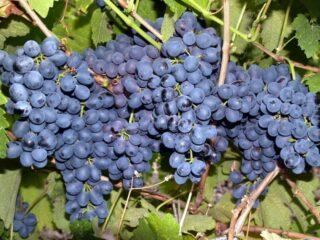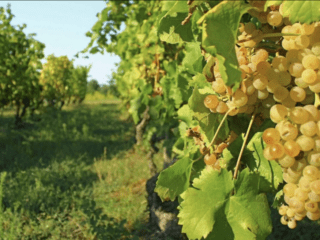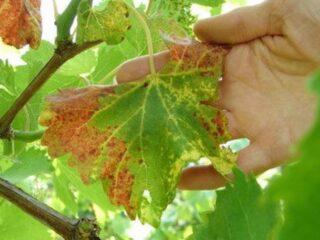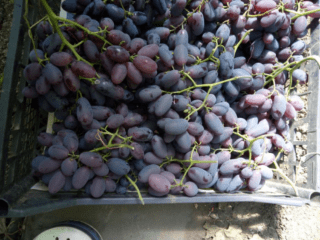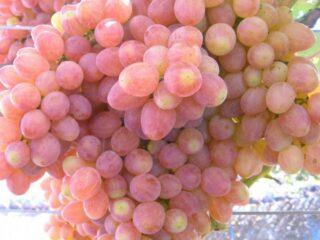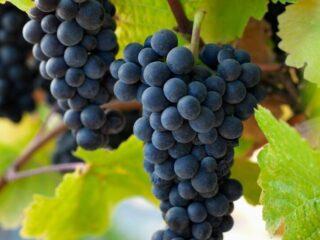Content
Rubin Golodrigi grapes are a technical variety. Home wine producers and professional farmers value it for its fast growth rate and consistently high yields. The variety is also cold-resistant, sufficient for many Russian regions.
History of selection
Ruby Golodriga is one of almost 40 grape varieties created by the Soviet breeder P. Ya. Golodriga, who worked in Crimea from the 50s of the twentieth century until the introduction of Prohibition by M. S. Gorbachev. The “parents” were the Ruby Magarach and its seedling from free pollination, which received the “code name” Magarach 6-68-27.
Golodriga ruby was actively grown on an industrial scale from the mid-70s to the end of the 80s of the last century. It was not listed in the Soviet State Register of Breeding Achievements, but has been included in the Russian Register since 2008. The originator and applicant is the Ukrainian LLC NVF Ampelos.
Description of the Rubin Golodrigi grape variety
Ruby Golodrigi is a black grape variety. The brushes look very presentable.
Bunches
The clusters are relatively small (about 150 g), one-dimensional. With very high-quality care and planting in an ideal climate, they can gain weight up to 350 g. They are cylindrical or cone-shaped in shape.
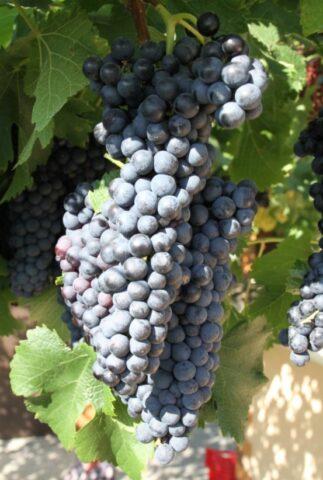
Most clusters are very dense, even slightly loose clusters are rare
Berries
The berries are almost spherical, one-dimensional, weighing about 5 g. Even at the stage of full ripening, they firmly adhere to the ridge and do not crumble.
The skin is inky purple (appears black from a distance), covered with a dense layer of bluish-gray “waxy” coating (pruin). The pulp is greenish, very juicy.
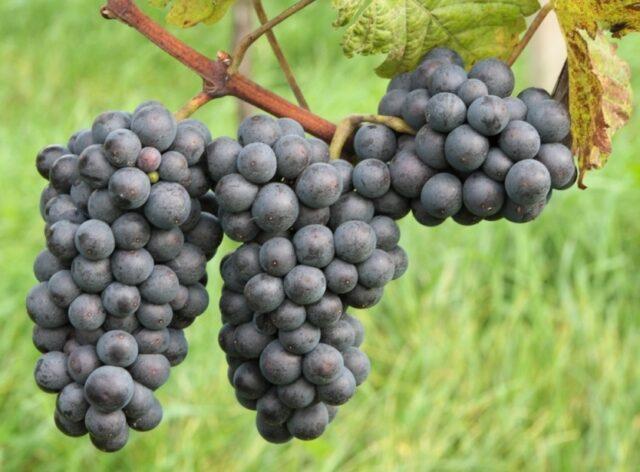
Each berry contains 3-4 small seeds
Vine
The vines are of medium vigor and are characterized by good ripening along the entire length of the shoots. If Rubin Golodrigi grapes are cultivated in regions ideally suited for them, they are characterized as vigorous.
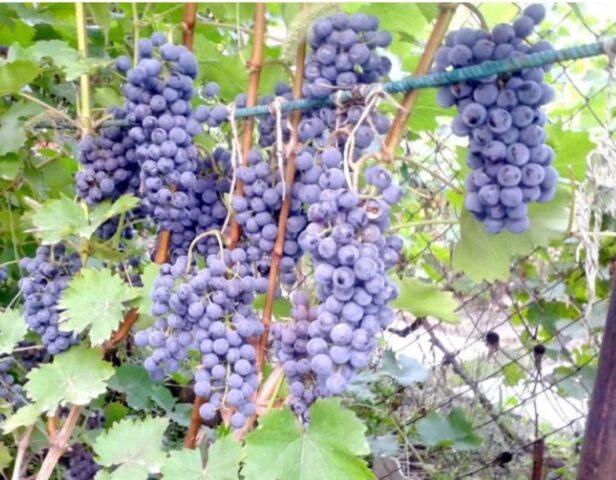
Rubin Golodrigi grape vines add up to 3 m per season
Characteristic
Ruby Golodrigi is a technical grape variety. The berries are intended for the production of table and dessert wines. The finished products are highly rated by professional tasters - 7.8-8 points.
Ripening period
The variety belongs to the mid-late variety. Rubin Golodriga grapes reach technical ripeness around mid-September. However, the ripening time for berries varies (110-125 days) - they depend on the climatic conditions of the region and the weather during the growing season.
Productivity
When cultivated on an industrial scale, the yield is 140-150 c/ha.Amateur gardeners remove up to 9-10 kg of berries from mature vines.
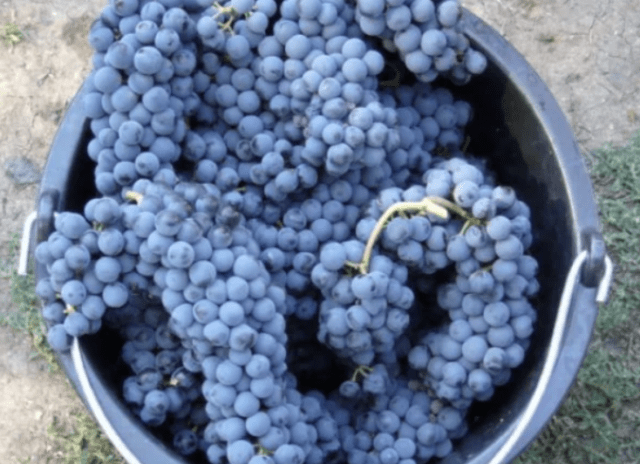
The vines bear fruit for the first time in the third year after planting
Taste
Experts “identify” Rubin Golodrigi grapes by their pronounced “nightshade” flavor. The taste is quite balanced, high sugar content (210-240 g/dm³ or 21-24% on the Brix scale) is “balanced” by acidity (9-11 g/dm³). However, the latter is quickly “lost” if the harvest is not harvested on time.
Frost resistance
The cold resistance of the Rubin Golodrigi variety is down to -26 °C. This is a pretty good indicator for grapes.
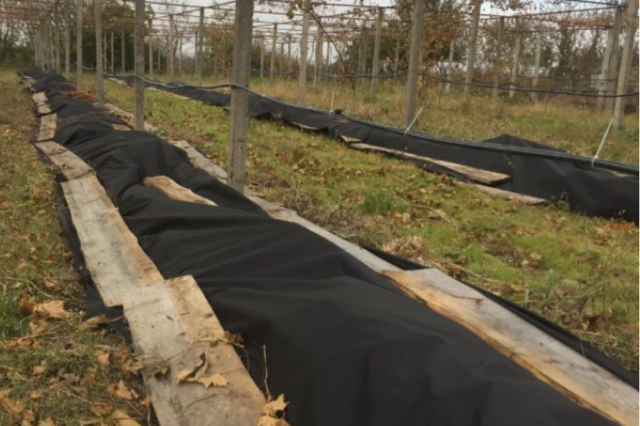
In subtropical climates, Rubin Golodriga grapes will overwinter without shelter
Growing regions
Rubin Golodrigi grapes are suitable for planting not only in the southern regions of Russia (North Caucasus, Crimea), but also in temperate climates. The vine under cover successfully survives even the Ural and Siberian winters; the future harvest is rarely subject to return frosts, since leaf and flower buds open relatively late.
Drought resistance
The Rubin Golodrigi grape tolerates short-term drought relatively well. But if watering is often neglected, the berries dry out, lose their juiciness, and their ripening process is greatly inhibited.
Resistance to diseases and pests
Rubin Golodrigi grapes have field resistance to the most dangerous fungal diseases for the crop - mildew, oidium, gray rot. This means that it is not immune from infection, but successfully resists the fungus.The damage to the vines and the harvest will be minimal, especially if you “help” the grapes in time by treating them with fungicides.
The variety is immune to phylloxera. Other pests are not particularly interested in Rubin Golodrigi grapes, even if they attack neighboring vines.
Keeping quality
Thin but durable skin provides good shelf life and transportability. The berries can withstand even long-term transportation without damage and can be stored for up to a month under optimal conditions.
Advantages and disadvantages
The original “nightshade” notes provide wine from the berries of the Rubin Golodriga variety with a unique taste. This is especially true for dry versions aged in natural oak barrels.
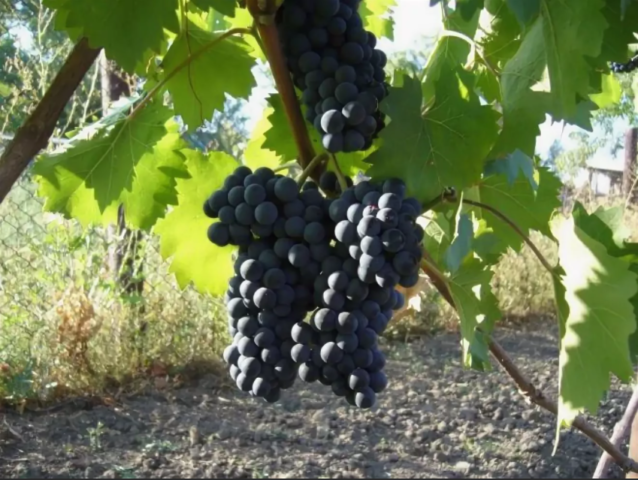
Rubin Golodrigi grapes are a very successful combination of general endurance and presentability of the berries
Pros:
- frost resistance is very good for grapes;
- resistance to the most dangerous diseases for the crop, immunity to phylloxera, lack of interest from other pests;
- good ripening of vines;
- consistently high productivity;
- annual fruiting (without “rest” seasons);
- self-pollinating;
- long shelf life, good transportability;
- resistance to short-term drought, low temperatures, and their sudden changes;
- precociousness.
Minuses:
- dependence of ripening time on climatic and weather nuances;
- relatively small size of berries and clusters;
- the need for pinching, forming vines and rationing the harvest throughout the season.
Features of growing Rubin Golodrigi grapes
For growing Rubin Golodrigi grapes, the simplest trellises are quite suitable, which are vertical supports installed at intervals of 2-3 m, on which wire is stretched horizontally in several rows. If the vines are cultivated in temperate and more severe climates, the first tier is made quite high, about a meter from the soil level.
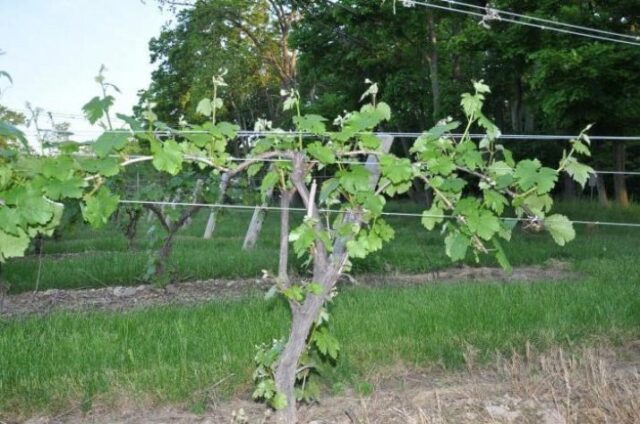
Do not tie the vines to the trellis too tightly so as not to damage them
To make it more convenient to care for the vines and harvest, the length of the vines is most often limited to 1-1.5 m. But there are also those who practice growing it on higher (1.6-1.8 m) trellises, giving long (2 ,5-3 m) shoots just hang from them.
Mandatory agrotechnical practices for Rubin Golodrigi grapes are pinching and breaking off “extra” shoots. This needs to be paid attention throughout the season. Such measures are necessary in order to avoid thickening of the bushes and to provide all the clusters with warmth and sunlight “equally”.
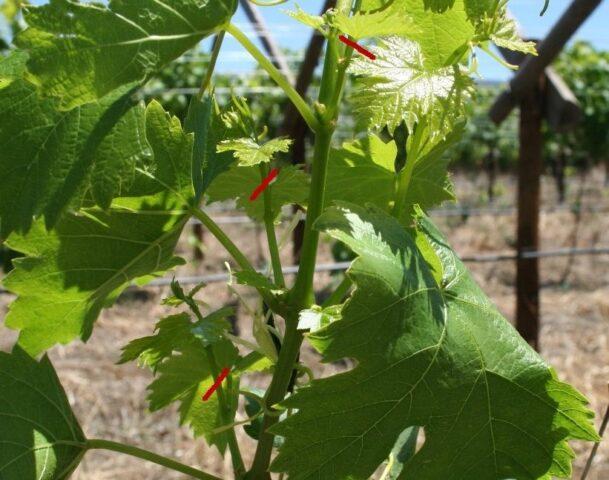
Everyone knows what the “stepchildren” of tomatoes look like, so it is also not difficult for gardeners to “identify” them on the grapevine.
It is also necessary to ration the harvest. The average for an adult Ruby Golodrigi vine is 50 “eyes”. If it is heavily “overloaded”, the grapes will only be suitable for squeezing juice. The most stringent rationing is practiced if the harvest is intended for the production of elite premium wines.
Landing
Rubin Golodriga grapes can be planted in both autumn and spring.The first option is traditionally preferred in the south, the second - in central Russia and other areas with a temperate and more severe climate. In the fall, you need to adjust the timing so that there is at least a month left before the first frost. In the spring you will have to wait until the likelihood of a strong drop in temperature is minimized.
The site for planting Ruby Golodrigi grapes is chosen taking into account the “requirements” of the culture:
- Good lighting.
- The presence of a barrier at a short distance from the vines that does not cast a shadow on them, but protects them from cold winds and drafts.
- Light, loose, but at the same time nutritious substrate with a neutral acid-base balance.
- Groundwater lying deeper than 3 m below the soil surface.
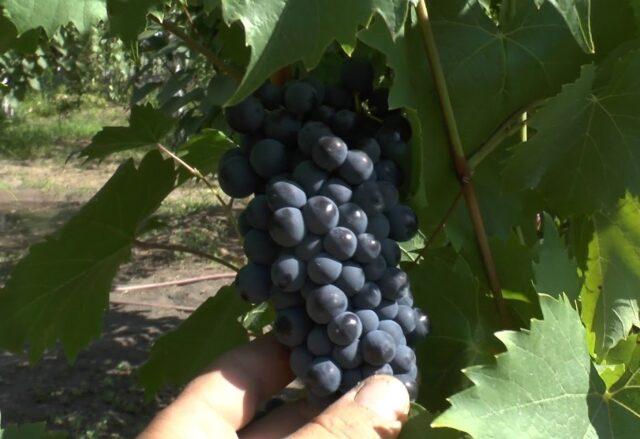
With a lack of sunlight, the yield volume and quality of Rubin Golodriga grapes decrease sharply
When planting several specimens at the same time, Rubin Golodrigi grape seedlings are placed at a distance of 2.5-3 m. The interval between rows is 3-4 m.
Pruning Ruby Golodriga grapes
The pruning method depends on the growing region. In the south, where the climate allows you to do without shelter for the winter, a one- or two-sided high-standard cordon is recommended.
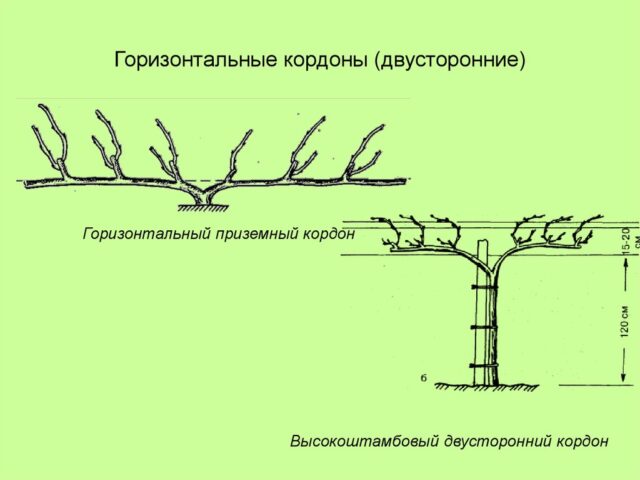
The presence of one or two “shoulders” at the cordon allows you to normalize the grape harvest
The Rubin Golodrigi grape, cultivated in the Moscow region and central Russia, is shaped in the form of a fan or half-fan. The same applies to regions with harsher climates.
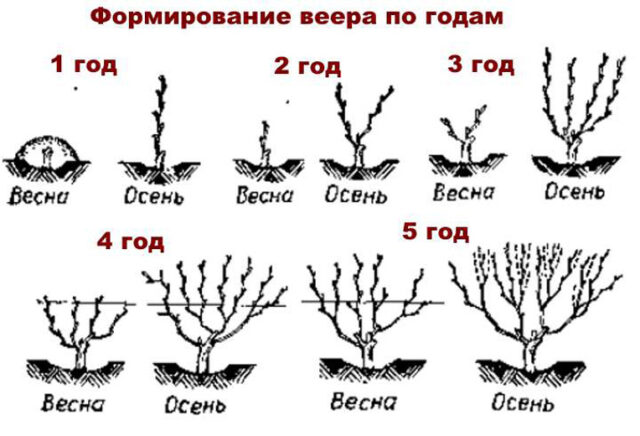
The vine, shaped like a fan, is well ventilated, there are no clusters “deprived” of heat and sunlight
Watering
To obtain large and juicy berries of the Rubin Golodrigi grapes, they practice two watering schemes:
- Frequent. The substrate is moistened approximately once every two weeks, excluding the flowering period. The soil needs to be wetted 0.5 m deep.
- Rare. The intervals between watering are determined individually, taking into account the age of the vine, the ripening time of the berries and other indicators. Tables specially compiled by professional agronomists are used as approximate guidelines.
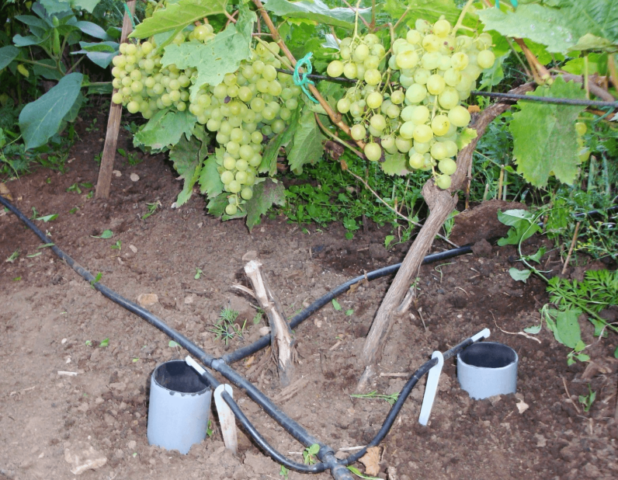
Pipes for watering grapes, allowing the substrate to be wetted to the required depth, are usually dug into the soil during planting.
Conclusion
Those who produce home wines or cultivate vines on an industrial scale appreciate the Rubin Golodriga grapes for their relative ease of care, high immunity and productivity. It is also noted that in terms of varietal characteristics it is very similar to the famous Cabernet Sauvignon.
Reviews of Rubin Golodriga grapes
